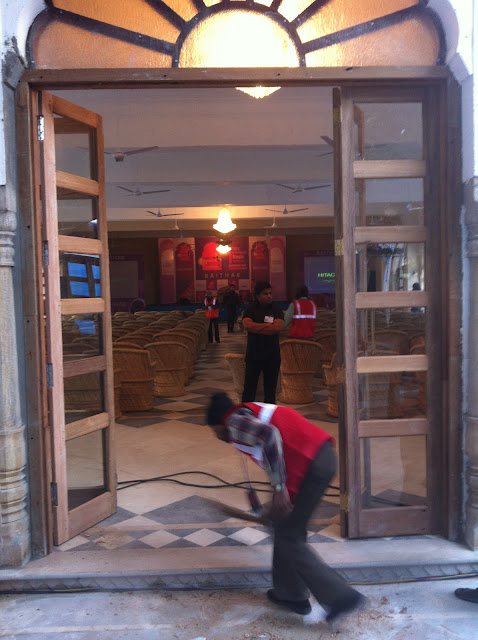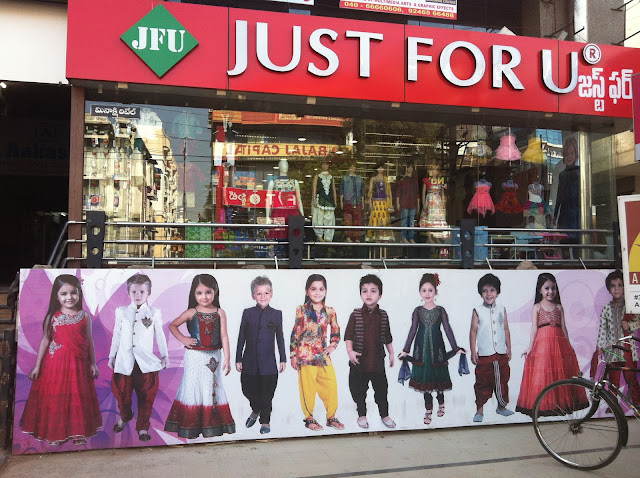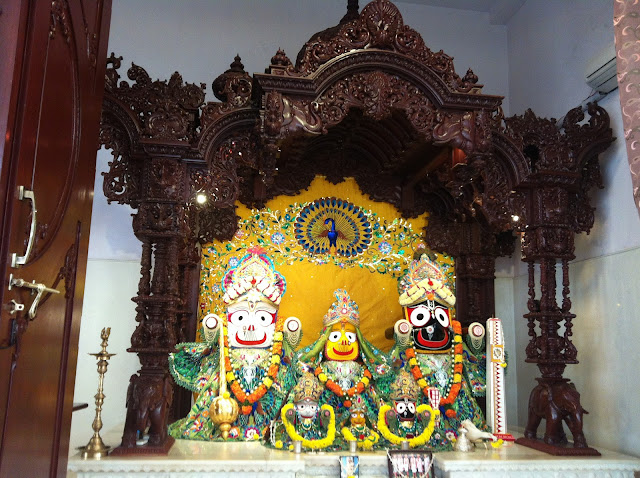Thai illuminated statues for New Year 2013 at Chiangmai Airport...
the international/multicultural touch. Sawatdii bpii-mai !!
Off to India [yet] again...
But first stop after leaving home in Chiangmai was Bangkok, where we bumped into His Royal Poochiness, Kuhn Tongdaeng, looking a bit darker than usual:
Into India through Chennai, then to Kovalam via Thiruvanathapuram (yeah, I know, I can't pronounce it either). Stayed at Uday Samudra 'Resort', but not through choice - lots of inconsiderate and noisy Russian smokers.
It was fifteen minutes walk to the main beaches to the south, but pleasant enough in the early morning, as it turned out.
As always, a little rubbish along the path. Ah, that aroma of burning plastic... Velgum to Injeer, my vrend...
Women always 'swim' like this, in full dress. No-one, except some of the more brazen westernized men, wear swimming togs. Women have to cluster together like this for protection from the endless roving gangs of oggling men.
There are two distinct beaches at Kovalam. This is the Indian beach. The other is the European beach with most of the restaurants and tourist infrastructure. It's not an official segregation, but evidently voluntary:
Where's Wally? The photographer takes a break...
On the Indian half of Kovalam beach,morning fishermen pull in nets... not much catch that morning.
Via Mangalore, we went to Kannur, a small village on the northern coast of Kerala. Stayed at Costa Malabar, a very pleasant homestay cottage on a cliff overlooking the Arabian Sea. Very good Indian food, and pleasant company:
...with its private beach:
Would we like to go and see some ancient voodoo rituals?
Why yes, of course, thank you so much.
Actually, it turned out to be the best thing we did on the entire trip. The ceremonies are called Theyyam, devoted to the god of ancestors, Karanavar. So, up at 3.30am and off to a temple where we were told ordinary people would be ritually turned into gods...
Here's the first god we saw:
He had already done his dance and was up to the part of the ritual where he was blessing people:
...and then more gods.
This is apparently a very old tradition, pre-Hindu, and with its roots in African Voodoo beliefs. Surprisingly, these are low caste citizens, not Hindu priests. There is a handful of families who maintain age-old traditions of ancestor-worship. Through ritual, family members are changed into gods. Not pretend gods, but real ones. They all believe that their brother/uncle/father has actually become a god, magically transformed into one of their ancestors. That enables them to seek a blessing... like getting it straight from the horse's mouth, as it were. It's an interesting form of social inversion, with some higher caste people seeking blessings from those who are normally regarded as socially inferior, eg, Dalits.
The headgear and costume is extremely heavy, we were told. It takes a lot of practice and strength to endure dancing around in it:
The god (in the headgear) is shadowed all the time by his nemesis, the skinny guy in red waving a threatening-looking weapon(?). I suspect he's a metaphor for the unavoidable presence of both good and evil.
Men got the first blessings - of course. Velcome do Injeer. Mere women had to vait their durn.
The (palm?) tree is carefully built up by the 'priests', lighted with tapers, then gradually demolished as the god and friend dance around it. I thought back to the Hindu gods of Brahma the Creator, eternally balanced by Shiva the Destroyer. As they danced, they carefully avoided one another... see the video.
...and after the dance the women got their turn:
That was so much fun we asked to go to another Theyyam the next morning. When we got there, the designated god was still in the make-up room, giving himself what might be construed as breasts:
Once dressed, he had to get his magic headgear on:
...and hey presto, he's a god.
Men first:
...then the [noisy] dance. See the video.
...and the vimen queue up to get the leftovers:
Onward, north through Mumbai to Jaipur, where Road Rule #1 is... GIVE WAY TO ELEPHANTS.
Entrance to the Festival venue, Diggi Palace:
Indian Police Security borrowed old British guns from the Honourable(?!) East India Company :
Despite the problems encountered during our visit last year with Muslim extremist threats and overcrowding, the owners of Diggi Palace had worked hard to upgrade the site capacity. On the negative side of the ledger, the music stage and the official restaurant had to be shipped out to a hotel some half-hour away through smoggy traffic... and we had to pay the fare!! We had forked out to be sponsors ('delegates') this year, but were not informed of the changes - so had to go to outside restaurants to eat. Not happy. If we do come back to Jaipur again (due to some seriously good authors being invited), we won't be delegates again... no longer worth it.
This was the new venue in 2013... where the music stage used to be in 2012:
...and the Baithak venue was now a hall, not a tent. It was so new that the carpenters were still sweeping up wood-shavings from finishing the doors:
Early morning on opening day at the Front Lawns, a Writer ventures in:
...and seats begin to fill, ready for the Tibetan Buddhist monks' chanting. It was a cross between growling and rhythmic groaning, overlaid with the general din of conversation, plus the effervescent tinkling of annoying Nokia Ringtones. Yes, THAT tune is still alive and well in India. Turn your watches back one hour and fifteen years. But as luck would have it, we sat next to an Extremely. Fat. Indian lady who was crunching away noisily on a packet of "Hippo Toasties". Had to laugh. Politely.
Right next to the palace were slums... rich and poor live cheek by jowl in India:
...and life went on as usual in Jaipur. Here the school tuktuk clatters off with its load of children:
After the festival it was Mumbai and its British Raj architecture. It's jaw-drop stuff, specifically intended to out-do Indian architecture - just to show 'em who's boss:
Mumbai is an inseparable mix of old and new. Here's a water-cart protected by Lord Krishna himself:
But sometimes the new dominates, especially when it comes to tacky tourist bullsh!t....
Short flight to Pune, where the Raja Dinkar Kelkar private museum is very much worth a visit. Here are some musical instruments of note - some peacock sitars, a 3-headed tabla drum, and a pair of tamburas amplified by horn like the antique 'Stroh' violins:
Shop windows just ain't the same in Injeer:
Then to Vijayawada and a temple dug down into solid rock. Ground level is where you see the trees in the background:
In the back streets of Hyderabad:
Er, no comment...
Ganesh temples are where you find them, even in the middle of an intersection:
...and if you're illiterate, lack a 1930s typewriter, or need a letter done, you can visit the Town Scribe who had an edjermacation to learn to rite:
The museum at Hyderabad was OK too:
...but the bowls of soup in the canteen were smallish:
When I saw this shop I thought of my grandchildren... but then, luckily for them, I changed my mind:
Gaanesh again. You'd think an ancient god would have developed a sense of modern traffic rules by now:
OK, it's the Fisheries Dept, Hyderabad:
Wally's not hard to spot at Golconda Fort, a ruined 16th-century city about 10k to the west of Hyderabad. It apparently used to have a vault where the Kohinoor and Hope diamonds were stored. We didn't find any more, though.
Pretty good for lawn which hasn't been mowed since the 16th-century.
These anti-elephant spikes have been shortened and blunted so drunk Russian tourists won't accidentally gouge their eyes out:
Care to wander up the outer stairs?
Although it was a Muslim fort, Hindus felt it was quite appropriate to plonk a Hindu temple almost at the highest point:
Ever upwards to the high point...
...then down:
...into the bowels of the fort where all the offices and clerks used to work. No quill pens left lying around, I noted:
Then to the Chowmallah Palace, which serves mostly as a museum these days in order to earn its keep.
Since Marie left India, all the shops are stocking pink stuff.
Indian newspapers always provide a jaw-drop or two. Yep, illiteracy and lack of education can carry a high price:
The Undavalli cave temple at Vijayawada, carved into solid granite. Don't worry, Marie is using an authentic 8th-century iPhone:
It began life in the 8th century as a Buddhist monastery - the rough-hewn ground- and first- floor meditation rooms. Later it was occupied and extended by Hindus, and the statuary and icons changed accordingly:
Eighth-century script...
...which these days can only be read by monkeys:
No, it's not a 19th-century Romantic landscape. It's the 14th-century Kondapalli Fort at Vijayawada. The Brits took it over and put a garrison here in the 19th century:
This was originally the Dancing Hall. I can only imagine what the Brits might have used it for...
...and this was the prison. It must have been the coolest spot in summer.
Moral: Be bad, Stay cool:
Chennai-sized Paper Dhosa. As Rani commented, 'Do you eat it or launch it?'
Fort George in Chennai was a British thing, except back then Chennai was Madras. Below is a pic of one of the barracks. All the streets have London names... cute but a tad 'try-hard':
Yep, Colonialism's OVER, chaps. Except these days it's called Globalization. There was a MacDonalds not far from here...
Chennai has a way to go before it hits the retail highs of Thailand: this is their best effort. The noise of the dance competition on the ground floor stage made my nose vibrate. Note again the vast preponderance of males. Hardly any females in sight - exactly the opposite of what one might expect in a shopping centre in most countries. Maybe except Saudi, Yemen, Sudan, Israel...
But we found the one place in Chennai which offered silence, freedom to be a woman, and wifi...
...then took a tuktuk down the coast road to the pink-coloured Ice House, where in the 1860s(?) some Yank guy began importing large blocks of ice from Canada, of which 30% melted en route to Injeer. This was the (well-insulated!) storehouse in Madras. Very profitable business untill refrigeration got invented.
Cheap way of blanketing a building site:
Shiva temple near Mammalapuram with snake stones, worshipped for fertility. Cobra is a fave:
Krishna temple. Hare hare rama rama krishna hare hare.................. etc
The eighth-century "Shore temple" at Mallapuram:
Built close to the - yes, the shore - it has suffered huge erosion from wind and salt. These carvings would have once been intricate and detailed:
The Five Rathas. Each item was carved from a large boulder, including the temples:
Hair colour is the only clue...
Marie is now officially only one hair-dye treatment away from being an Indian.





























































































